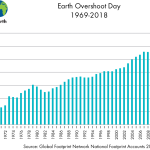
How Fast is Our Goose Being Cooked? (podcast episode 18)
Is Earth Overshoot Day meaningful? How sound is ecological footprint and biocapacity data behind it? Dave and Grace examine a critique from Robert B. Richardson, Associate Professor of Sustainable Development at Michigan State University.
Plus: This summer’s heat and fires are NOT “the new normal.” (It will get worse. Sorry.) More forest fire destruction comes with climate change. If you want to be a green hero, recycling is not nearly enough. How women who decide not to have children are treated. Men should take more responsibility for contraception.
Note: The forest fire story mentioned in this podcast as from the Washington Post was actually an AP story.
MENTIONED IN THIS EPISODE:
Earth Overshoot Day episode (#16) of the GrowthBusters podcast
Global Footprint Network Ecological Footprint Data
To Kid or Not to Kid documentary
The Race of Our Lives Revisited by Jeremy Grantham
James Hansen’s Temperature Updates
Science Says: Hotter Weather Turbocharges US West Wildfires
Subscribe (free) so you don’t miss an episode:
Tags: Climate Change, footprint, overshoot, sustainability
Trackback from your site.








James Herman
| #
I would love to see you tackle ending exclusionary zoning which prevents people from living in small homes. I consider myself an exclusionary zoning refugee. After I lost my job at 59 in October 2008 I decided to just retire. I lived in a mobile home park for 18 years. Prior to that I rented an apartment for 17.5 years and lived in the barracks for 3.5 years while on active duty in the Navy Reserves. The mobile home park was 17 miles from downtown Detroit. I paid enough in lot rent over that 18 year period to buy the lot over 7 times. If I wanted to stay in Michigan then I would’ve had to move 167 miles farther north. Instead I moved my singlewide to a residential lot 280 miles further south about 55 miles NE of Cincinnati at Rocky Fork Lake 10 miles from Hillsboro. 240,000 people left Detroit between 2000 and 2010. They left but the houses remained. Almost all those houses have been torn down. “This Old House” had a remodel in Detroit last season. Tom Silva remarked that Detroit has 30,000 more houses that they want to tear down. But Detroit still has exclusionary zoning. Isn’t some property tax money better than no property tax money? Sure it is. As long as a home is not a threat to anyone’s health or safety then it should not be prohibited. Thanks.
Reply
Dave Gardner
| #
Thanks, James. We may well get to this, but it’s not a super-high priority because it’s a little bit downstream from addressing root cause. We do, however, spend a little bit of time discussing these downstream responses to overshoot.
Reply
Brian Sanderson
| #
Hi Dave,
Of course Footprint estimates are an incomplete metric. From the point of view of a hard scientist, they’re also fuzzy.
But so what? If estimates of human population are not enough to carry a rational argument to explain that which plainly obvious to any rational being then why would we expect some other number to do the job?
My point is this, we don’t live in an age of reason. Humanity never has. Most vote with their feelings about what they want and how they wish things should be.
Indeed, I have to wonder about the Associate Prof of Sustainable Development. He says:
Since the Industrial Revolution, the world economy has grown dramatically. Overall this is a success story, since rising incomes have lifted millions of people out of poverty.”
Well, since the beginning of the Industrial Revolution the human population has increased by almost 7 billion. So, if only millions have been raise out of poverty then billions have been born into poverty. And yet the Associate Professor of Sustainable Development calls this a success story”.
It’s not. It is a failure of civilization. It is a failure of reason. And “Sustainable Development” is an oxymoron. I can’t help but suspect that the Profs of Sustainable Development are Fifth Columnists.
Reply
Dave Gardner
| #
You have a point, Brian! I’m definitely not a big fan of the term (and most of the practice of) “sustainable development.”
Reply
Karen Gaia Pitts
| #
Over a 10 year period, chances of getting pregnant (with average use) are:
96% spermacides
94% fertility awareness
94% sponge
92% withdrawal
91% condom (male)
86% condom (female)
72% diaphram
72% sponge
61% pill
46% depo-provera
8% copper IUD
5% female sterilization
2% levonorgestrel IUD
2% male sterilization
1% hormonal implant
So in the 30 years that a women has to worry about getting pregnant – if she not ready to permanently give up child-bearing – her chances of getting pregnant more than once while using the pill is quite high, and on the condom, even higher. I myself got pregnant twice on the pill, and once while using spermacides and withdrawal.
So it is best to quit promoting condoms, if you really want women to have fewer children.
Poor women cannot afford these LARC methods, and that is why, in 2011, poor women had an unplanned birth rate nearly seven times that of higher-income women.
In 2016, women in households with an income below the poverty threshold had the highest birth rate at 78 births per 1,000 women, compared to 44 births per 1,000 for women at 200% and above the poverty threshold. https://www.statista.com/statistics/562541/birth-rate-by-poverty-status-in-the-us/
The real answer to lowering U.S. fertility rates, instead of telling couples to have fewer children, is to provide universal health care with free effective contraception (and the necessary counseling on using it).
Reply
Dave Gardner
| #
Thanks for these stats, Karen. No doubt there are superior forms of contraception. Used correctly, I think condoms are higher on this list. And they do serve a useful purpose as a symbol of taking these matters into your own hands. But I am with you on making the best contraceptives available at no cost and with no barriers.
Reply
James
| #
Poverty is relative. Is it only being able to afford 1 TV and not 5? or having to ride a bike instead of a car because of choice or income? Or being a subsistence farmer, having only 1 electric light and being perfectly happy? Where is the line drawn?
Reply
Bill Dowling
| #
Great programme all round. Thank-you. I particularly appreciated the Global Footprint Critique.
One thing I would like to add is this. Apart from making no allownace for the depetion of non renewable resources, the GFN makes no allowance for the biocapacity required to support wildlfe, so it is no wonder we are losing otherr species at rates 1000x the natural rate. No doubt the 2018 WWF living planet report will once again tell us how much more they have been depletedsince 2016 . It is a great shame on them that they while they go into great detail on all the effects on wildlife, they never ever clearly explain the obvious cause to all the avid readers of their otherwise excellent reportf – too many of us!
If any other animal was overunning the planet, in such vast numbers and still breeding at the rate we are, and causing the immense destruction and loss of habitat we are, I am sure WWF would have suggested reducing its numbers long ago..
Reply
Dave Gardner
| #
Good points, Bill. Still, I see much value in the footprint data. It’s a lot better than nothing, and it is still improving.
Reply